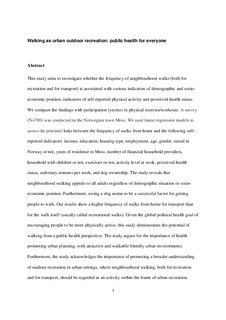| dc.description.abstract | This study aims to investigate whether the frequency of neighbourhood walks (both for recreation and for transport) is associated with various indicators of demographic and socio-economic position, indicators of selfreported physical activity and perceived health status. We compare the findings with participation (yes/no) in physical exercise/workouts. A survey (N = 780) was conducted in the Norwegian town Moss. We used linear regression models to assess the potential links between the frequency of walks from home and the following selfreported indicators: income, education, housing type, employment, age, gender, raised in Norway or not, years of residence in Moss, number of financial household providers, household with/without children, exerciser or not, activity level at work, perceived health status, sedentary minutes per week, and dog ownership. The study reveals that neighbourhood walking appeals to all adults regardless of demographic situation or socio-economic position. Furthermore, owning a dog seems to be a successful factor for getting people to walk. Our results show a higher frequency of walks from home for transport than for the walk itself (usually called recreational walks). Given the global political health goal of encouraging people to be more physically active, this study demonstrates the potential of walking from a public health perspective. The study argues for the importance of health promoting urban planning, with attractive and walkable friendly urban environments. Furthermore, the study acknowledges the importance of promoting a broader understanding of outdoor recreation in urban settings, where neighbourhood walking, both for recreation and for transport, should be regarded as an activity within the frame of urban recreation. Management implications: • Neighbourhood walking appeals to all adults regardless of demographic situation or socio-economic position. • Young adults and people who are better economically situated favour physical exercise more than other adults do. • In a world dominated by inactive adults, a moderate physical activity such as neighbourhood walking has great potential to improve public health. • Public health policy and management should facilitate efficient measures to stimulate neighbourhood walking. • Neighbourhood walking, both for recreation and for transport, should be regarded as an activity within the frame of urban recreation; both types are mostly performed in people's leisure time. • It is important to base urban planning on the principle of developing a walkable city. Physical activity Neighbourhood walking Physical exercise Socio-economic position Urban recreation Urban planning | nb_NO |
